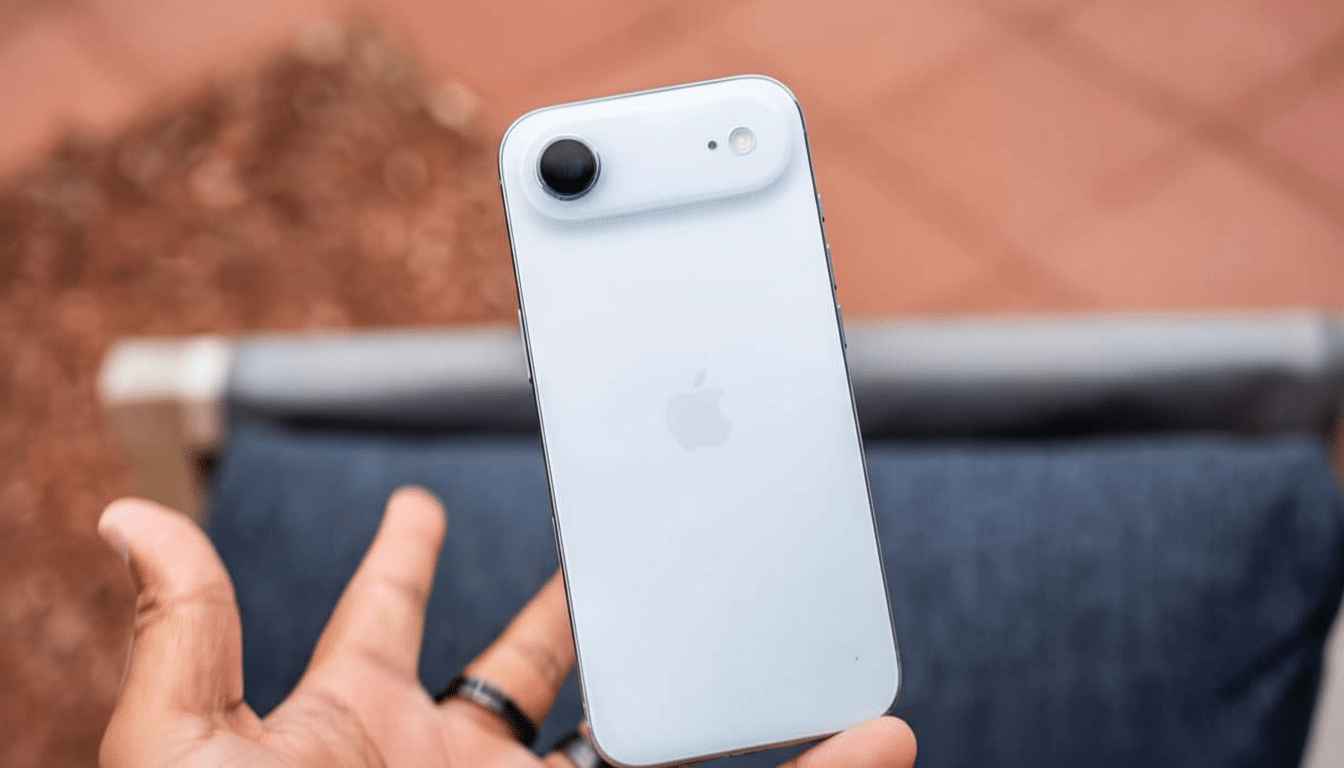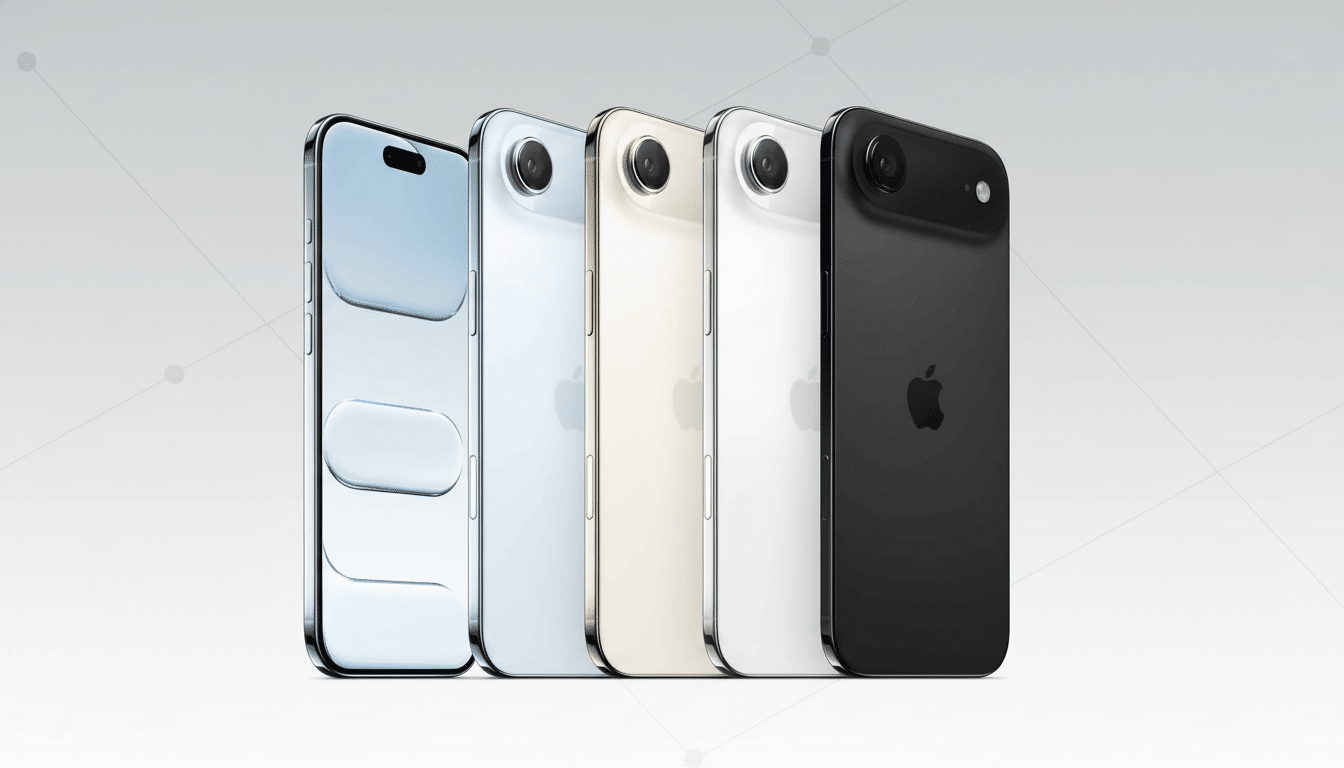It’s here: Apple’s new iPhone 17 and the iPhone Air, a mid-size Plus replacement so thin it makes the old model look like it never even was… and yet advising a shook-up new mainstream direction for Apple.
The iPhone Air doubles down on minimalism without skimping on upmarket flair, adding Pro-level display tech, a titanium frame and Apple’s most modern silicon to a supremely svelte but ambitiously spec’d device.

iPhone Air: Thin Design, Pro Display, A Big Camera Bet
The iPhone Air is Apple’s thinnest iPhone ever, measuring just 5.6mm thick: much thinner than last year’s models, and in the same design spirit as the ultra-thin iPad Pro. It’s a nice midpoint where the display size is large enough to use with one hand, but it also feels wide and spacious.
Apple brings ProMotion to the Air, making it capable of a variable refresh rate from 1Hz to 120Hz. For smooth scrolling, fluid animations, and power efficiency, that’s a significant step up and closes a long running gap between the Pro and non-Pro experience.
In a significant swing, the Air has just one rear camera: a 48MP Fusion main sensor, which Apple says is “multiple cameras in one” with sensor cropping and computational imaging to approximate focal lengths of different lens lengths. It’s a technique that’s similar to how other high-res phones crop sharp 2x, or even 3x, photos without having a separate telephoto. At the front, a square 18MP Center Stage camera provides a wider viewing angle and automatic framing.
The hardware package consists of a titanium frame—a material formerly reserved for its Pro devices—as well as an Action Button with Camera Control. The Air is now globally eSIM-only, which helped clear room for new radios and increased thermal pathways.
Starting price is $999 for 256GB, but there are also 512GB and 1TB tiers. Colors are space black, cloud white, light gold, and sky blue.
Chips, Connectivity and the Battery Strategy
Under the hood, the iPhone Air is powered by Apple’s A19 Pro chipset with a 6‑core CPU and 5‑core GPU. Inside there’s an Apple-built N1 wireless chip for Wi‑Fi 7, Bluetooth 6 and Thread for smart-home interoperability. Apple also mates the Air with an updated C1X modem.
Despite the thinness, Apple promises it will last up to 27 hours of video playback. Variable refresh rates as low as 1Hz, and the switch to eSIM-only, may also aid by allowing some internal volume to be freed up, and some power overhead to be excised. Wi‑Fi 7’s certification standards from the Wi‑Fi Alliance illustrate why Apple is fast-tracking adoption: With the technology’s multi-link support and wider channels, latency can be decreased and throughput increased in environments with lots of devices.
iPhone 17: Pro and Pro Max Coolers, Bigger Batteries
Reversals: The Pro models flip back to aluminum instead of titanium, reinforced by a new internal vapor chamber cooling system.\squeeze{\frac122}{600} It’s a practical shift: Benchmarks in previous generations have shown thermal spikes under heavy load; better heat dissipation will help to maintain performance for gaming, camera processing and on-device AI.

Apple rearranges the rear “plateau” in order to accommodate a bigger battery and eSIMs, and it adds Ceramic Shield to the back of an iPhone for the first time. The company claims up to 39 hours of video playback — an endurance number, if confirmed in testing, that would be a strong leap for the Pro line.
Displays are still 6.3 inches (Pro) and 6.9 inches (Pro Max) with ProMotion up to 120Hz, always‑on mode, and a claimed 3,000 nits peak outdoor brightness. You also get a 6‑core GPU, to match the 6‑core CPU, with the A19 Pro here. Connectivity is via the N1 wireless chip, but not the Apple C1 modem–suggesting Apple is still using Qualcomm modems for the top end handsets.
The camera system upgrades the telephoto to 48MP with up to 8x optical reach, equivalent to 200mm, and the 18MP Center Stage front camera is there to handle wider shots of groups of people without having to go into landscape mode. Storage now goes up to a larger and newly available 2TB option. Pro will start at $1,099 and Pro Max at $1,399, in deep blue, silver and a new cosmic orange.
Standard iPhone 17: Pro Features Trickle Downstream
The routine iPhone 17 takes things up a notch, with a 6.3-inch display and, at last, ProMotion and an always‑on display — two changes that make a material difference to the everyday experience. It’s powered by the A19 and N1 chips, includes an aluminum build, and ditches Apple’s C1 modem.
Apple says that it can last for up to 30 hours of video playback as you may live. The 48MP Dual Fusion camera supports 2x optical‑quality zoom thanks to in‑sensor cropping, the 18MP Center Stage selfie camera and square sensor deliver the same framing tricks as the rest of the family. Base price is $799 for 256GB, with colors in lavender, mist blue, sage, white and black.
Why the iPhone Air Is the Headliner
Apple’s transition from Plus to Air is about more than just a name. It captures a market in which buyers are demanding thinner, lighter phones that also feel premium. Consumer Intelligence Research Partners has long reported Apple’s top non‑Pro models lagging behind Pro/Pro Max models in buyer share; a thinner, sleeker “larger” alternative could make more sense than just “bigger.”
It also follows industry momentum: Premium phones over $600 account for more than half of global smartphone revenue, according to Counterpoint Research, and buyers in that bracket are increasingly prioritizing design and display-quality in addition to camera performance. With eSIM use growing (GSMA has noted expansion of operator backing around the world), the Air’s eSIM‑only veer arguably now feels less risky and more forward‑leaning.
Bottom line: iPhone 17 adds welcome feature parity to the lineup, but the iPhone Air is the one everybody will talk about. If Apple’s single‑camera philosophy proves to result in true multi‑focal flexibility and the thinness doesn’t heavily impact battery life, the Air could end up the go‑to for people ready for a Pro‑level feel, but not the Pro‑sized dent in the wallet.

